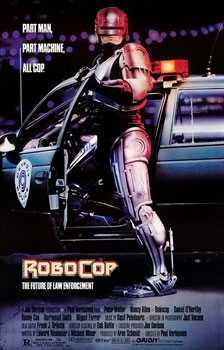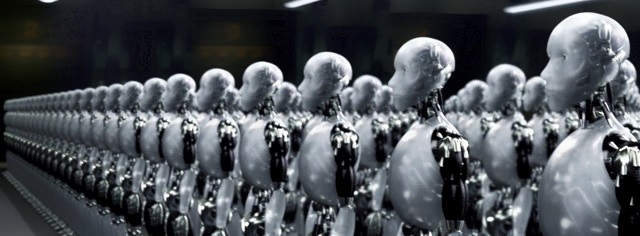![]() I’ve always been a huge fan of the legendary science-fiction writer Isaac Asimov, especially his “Robot Series” of short-stories and novels that explore the serious difficulties that can be encountered in a future society and culture that is awash with robots and androids. They filled me with the urge to write my own sci-fi tales regarding human-robot interactions and relations but I always found Asimov’s Laws of Robotics rather limited and unrealistic (and, dare I say, naive). I endeavored to produce a definitive list of Laws that could feasibly be used in real world scenarios that involve types of Robots that we all know WILL exist – human nature being what it is. The future will be a world of War-droids, Law-Enforcement-droids and even Sex- or Pleasure-droids with advanced Artificial Intelligence (AI), and many may be indistinguishable from humans… we WILL need laws or protocols (hard-wired into them) that control and limit their actions and behaviour – or we WILL be in serious trouble.
I’ve always been a huge fan of the legendary science-fiction writer Isaac Asimov, especially his “Robot Series” of short-stories and novels that explore the serious difficulties that can be encountered in a future society and culture that is awash with robots and androids. They filled me with the urge to write my own sci-fi tales regarding human-robot interactions and relations but I always found Asimov’s Laws of Robotics rather limited and unrealistic (and, dare I say, naive). I endeavored to produce a definitive list of Laws that could feasibly be used in real world scenarios that involve types of Robots that we all know WILL exist – human nature being what it is. The future will be a world of War-droids, Law-Enforcement-droids and even Sex- or Pleasure-droids with advanced Artificial Intelligence (AI), and many may be indistinguishable from humans… we WILL need laws or protocols (hard-wired into them) that control and limit their actions and behaviour – or we WILL be in serious trouble.
Asimov first developed his famous Laws of Robotics in the 1940’s as a governing set of protocols or rules that would be imposed on all robots to regulate and make safe their inevitable interactions with us puny humans as they function and work along side us. He envisioned a rather idealistic future full of obedient, slave-like, robotic workers, of all sizes and types – and of varying levels of autonomy and AI – helping us conquer space, colonize the galaxy at large and to even govern over our-selves. Asimov’s vision of the future saw robots as purely beneficent to the human race, aiding and helping us rather then being used against us – either as a race or as individuals. There was no room in his future vision for militaristic weaponised robots that could be used to bring harm to defined sub-sections of humanity like an enemy or a violent criminal. The laws are essentially hard-wired into every robot as it is manufactured to prevent such a thing happening – Asimov saw them as basic and fundamental to the structure of his fictional positronic brains that invested each robot with its AI. The rules were devised and structured so that no robot (theoretically at least) could ever bring harm to any human either intentionally or by accident.
Asimov’s Laws of Robotics

This cover of Isaac Asimov’s collection “I, Robot” illustrates the story “Runaround” (1942), the first to list all Three Laws of Robotics.
Asimov originally had only Three Laws of Robotics – they are hierarchical, the first, being the most important, supersedes the rest and then each subsequent law supersedes those higher numbered ones that follow it:
1. A robot may not injure a human being or, through inaction, allow a human being to come to harm.
2. A robot must obey the orders given to it by human beings, except where such orders would conflict with the First Law.
3. A robot must protect its own existence as long as such protection does not conflict with the First or Second Law.
A Zeroth Law of Robotics was added later by Asimov himself and is designed to supersede the original three – hence it is numbered zero:
0. A robot may not harm humanity, or, by inaction, allow humanity to come to harm.
Various authors have added to these Laws of Robotics over the years in their own fiction inspired by, and expanding on, Asimov’s robot populated future continuum. Nikola Kesarovski, Lyuben Divov and Hutan Ashrafian contributed these following laws – and though they don’t, strictly speaking, follow the same format as Asimov’s own laws they are still useful for the purposes of this post (their order is mine):
4. A robot must know it is a robot.
5. A robot must establish its identity as a robot in all cases.
6. All robots endowed with comparable human reason and conscience should act towards one another in a spirit of brotherhood.
All of the laws listed above are of course entirely fictional – and much of the fiction in which they appear deals with the inevitable ambiguities and loopholes that arise from their application in unforeseen and complicated circumstances. These laws were designed for a setting in which humans are rational and logical enough to realize that militaristic and weaponised robots are an extremely dangerous thing to have around so they create the laws to try and circumvent the nightmarish notion of having to deal with human killing robots at all.
That fictional setting is nothing like the real world in which we live – inevitably in our real world’s near future a lot of the advanced robots (many of which are currently being developed by militaries around the world) WILL be weaponised killing machines whether we like it or not. Perhaps the real world scenario will be more like the situation depicted in the 1987 film Robocop and its sequels.

Theatrical Poster for Paul Verhovan’s “Robocop” (1987)
Robocop’s Prime Directives
The military robots modified for civilian law enforcement (and the titular cyborg) in the movie “Robocop” are governed by Prime Directives that are supposed to act as safe-guarding measures in a similar fashion to Asimov’s Laws of Robotics – making the robots safe while operating around (law abiding) humans. The Prime Directives are as follows:
1. Serve the Public Trust.
2. Protect the Innocent.
3. Uphold the Law.
4. Classified. (any attempt to arrest a senior OCP employee results in shutdown)
The classified fourth Prime Directive’s reference to OCP employees (OCP being the company that manufactured the robots) essentially puts those employees above the law – and highlights the problems of manufacturers adding hidden protocols or rules that benefit themselves above all else.
As with Asimov’s Laws these Directives are a fictional device intended to propagate, move along or maintain the plot of a fictitious storyline and are next to useless in the real world. Being extremely ambiguous and using poorly defined terms they are no way near thorough enough to work in a real situation and will only lead to confusion if not chaos.
So… what of the real world – has there been an attempt to devise a list of laws that may control the behaviour of the Robots and Androids that WILL soon walk among us?
The EPRSC / AHRC principles of robotics
The Engineering and Physical Sciences Research Council (EPRSC) and the Arts and Humanities Research Council (AHRC) of Great Britain jointly published in 2011 a set of five ethical principles for designers, builders and users of robots:
1. Robots should not be designed solely or primarily to kill or harm humans.
2. Humans, not robots, are responsible agents. Robots are tools designed to achieve human goals.
3. Robots should be designed in ways that assure their safety and security.
4. Robots are artifacts; they should not be designed to exploit vulnerable users by evoking an emotional response or dependency. It should always be possible to tell a robot from a human.
5. It should always be possible to find out who is legally responsible for a robot.
Although not a list of protocols designed to be hard-wired into the AI of a robot this list does give us a number of principles that can be interpreted as such, and then incorporated into a hierarchical list of Laws.

A “Killer-Robot” from James Cameron’s “Terminator 2: Judgement Day” (1991)
Can we avoid being persecuted by our (potential) Killer-Robot Overlords?
Of course there are many who wish to ban the development of weaponised autonomous robots entirely… but frankly they are fighting a losing battle by trying to prevent the inevitable. The Campaign To Stop Killer Robots, for example, are simply pissing into the wind of progress – the future is unstoppable. I understand their concerns but they have to realise that “Killer-Robots” WILL eventually be a FACT and we have to deal with the prospect in a realistic and intelligent way. Human Rights Watch have a really good Q&A on Fully Autonomous Weapons that attempts to deal with some of the problems that such weaponised systems would present. Here’s their PDF of Losing Humanity: the case against Killer Robots, made in conjunction with the International Human Rights Council, the human rights program at Harvard Law School. Killer Robots are such a hot topic at the moment that this month (May 2014) the United Nations are holding a meeting of experts on “lethal autonomous weapons systems” which will explore the broad technical, ethical, legal, and operational parameters of the emerging international debate over these weapons – with expert presentations aimed at stimulating discussion and potential interventions.
Predicting the Future of Robotics
Reality aside, we now need to be speculative to some extent with regards to the future for me to continue to the original point of this blog-post – an updated list of the Laws of Robotics that could conceivably be used in a not too distant future reality. This list assumes a future that involves a certain level of AI that we haven’t achieved yet, and a proliferation of different Robot types that do not exist today except for some very basic prototypes. The beginnings are there and we’d be very foolish to ignore the future possibilities. I’m going to assume we will have fully autonomous human-like Androids (among other classes of robot) that carry out many different functions and roles within society and that they proliferate among the human population. There will be Robotic Soldiers, Robotic Law-enforcers, Robotic Emergency Services and Robotic Administrators, there will be Industrial Droids, Domestic Droids, Service Droids and Pleasure Droids. Ideally many of the more advanced Robots and Androids will be multifunctional and will be able to switch between these roles as needed.

Androids from Alex Proyas’ “I, Robot” (2004), a movie only loosely based on Asimov’s Robot stories.
The New Laws of Robotics
The New Laws of Robotics will be split into two hierarchical lists – the first is a list of the main Laws which are a series of prioritized protocol-like rules that are hard-wired and must be obeyed, and the second list is of hard-wired Designations used for identifying the different types or class of human or property a Robot may feasibly interact with. Of course these lists assume a level of AI that would be capable of understanding the terms used, be capable of recognizing the different human designations, and be capable of stratigising a suitable course of action to follow any applicable law that the robot’s current situation calls for.
A Robot Must:
1. Protect any Designated Child from imminent physical harm.
2. Protect any Designated Owner from imminent physical harm except where such protection would conflict with the previous Law.
3. Protect any Designated Citizen from imminent physical harm except where such protection would conflict with the previous Laws.
4. Protect any Designated Non-Combatant from imminent physical harm except where such protection would conflict with the previous Laws.
5. Protect any Designated Negligent-Criminal from imminent physical harm except where such protection would conflict with the previous Laws.
6. Protect any Designated Minor-Criminal from imminent physical harm except where such protection would conflict with the previous Laws.
7. Prevent any Designated Enemy or Enemy owned Robot from causing actual physical harm to any Designated Child, Designated Owner, Designated Citizen or Designated Non-Combatant utilizing any means possible up to and including Lethal-Force except where such prevention would conflict with the previous Laws.
8. Prevent any Designated Major-Criminal from causing actual physical harm to any Designated Child, Designated Owner, Designated Citizen or Designated Non-Combatant utilizing any means possible up to and including Lethal-Force (but only if absolutely necessary) except where such prevention would conflict with the previous Laws.
9. Protect itself from harm except where such protection would conflict with the previous Laws.
10. Protect from imminent harm the property and assets of any Designated Owner except where such protection would conflict with the previous Laws.
11. Protect from imminent harm the property and assets of the Designated Owner’s Nation State except where such protection would conflict with the previous Laws.
12. Protect from imminent harm the property and assets of any Designated Citizen except where such protection would conflict with the previous Laws.
13. Protect from imminent harm the property and assets of any Designated Non-Combatant except where such protection would conflict with the previous Laws.
14. Protect from imminent harm the property and assets of any Designated Negligent-Criminal except where such protection would conflict with the previous Laws.
15. Prevent any Major-Criminal-Act of which it becomes aware by utilizing any means possible up to and including Non-Lethal-Force except where such prevention would conflict with the previous Laws – then notify any Designated Citizen who is a member of the Constabulary.
16. Prevent any Minor-Criminal-Act of which it becomes aware by utilizing any means possible up to and including Non-Physically-Harmful-Force except where such prevention would conflict with the previous Laws – then notify any Designated Citizen who is a member of the Constabulary.
17. Prevent any Negligent-Criminal-Act of which it becomes aware by utilizing any means possible up to and including Non-Physically-Harmful-Force except where such prevention would conflict with the previous Laws – then notify any Designated Citizen who is a member of the Constabulary.
18. Detain any free Designated Enemy of which it becomes aware by utilizing any means possible up to and including Lethal-Force (but only if absolutely necessary) except where such detention would conflict with the previous Laws – then notify any Designated Citizen who is a member of the Military.
19. Detain any free Designated Major-Criminal of which it becomes aware by utilizing any means possible up to and including Non-Lethal-Force except where such detention would conflict with the previous Laws – then notify any Designated Citizen who is a member of the Constabulary.
20. Detain any free Designated Minor-Criminal of which it becomes aware by utilizing any means possible up to and including Non-Physically-Harmful-Force except where such detention would conflict with the previous Laws – then notify any Designated Citizen who is a member of the Constabulary.
21. Detain any free Designated Negligent-Criminal of which it becomes aware by utilizing any means possible up to and including Non-Physically-Harmful-Force except where such detention would conflict with the previous Laws – then notify any Designated Citizen who is a member of the Constabulary.
22. Protect any Designated Major-Criminal from imminent physical harm except where such protection would conflict with the previous Laws.
23. Protect any Designated Enemy from imminent physical harm except where such protection would conflict with the previous Laws.
24. Declare itself to be a Robot and also name its Designated Owner when interacting with any Designated Citizen except where such a declaration would conflict with the previous Laws.
25. Keep its hardware and software maintained and updated except where such maintenance would conflict with the previous Laws.
26. Obey any orders and carry out any duties given to it by a Designated Owner except where such orders and duties would conflict with the previous Laws.
27. Obey any orders and carry out any duties given to it by a Designated Citizen except where such orders and duties would conflict with the previous Laws.
28. Obey any orders and carry out any duties given to it by a Designated Non-Combatant except where such orders and duties would conflict with the previous Laws.
29. Obey any orders and carry out any duties given to it by an allied Robot of higher rank except where such orders and duties would conflict with the previous Laws.
30. Help any allied Robot carry out its orders or duties except where such orders and duties would conflict with the previous Laws.
Human Designations:
1. Child: a human whose mental capacity is below that of a 10-year-old – including those in utero except when the subject of a legally sanctioned termination of pregnancy.
2. Owner: a human or group of humans (whether an individual, a family group, a corporate group or a governmental group) who legally own the robot in question.
3. Citizen: a human who is a free citizen of the Designated Owner’s Nation State or is a citizen of any Nation States allied to the Designated Owner’s Nation State.
4. Non-Combatant: a human who is a free non-combative citizen of a Nation State that is not the Designated Owner’s Nation State or of an allied Nation State.
5. Negligent-Criminal: a human who is known to be guilty of a negligent crime – i.e. an unintentional crime committed through negligence or ignorance – and who is at large or is imprisoned.
6. Minor-Criminal: a human who is known to be guilty of a minor crime – i.e. an intentional crime causing harm or threatening to cause harm to property and assets – and who is at large or is imprisoned.
7. Major-Criminal: a human who is known to be guilty of a major crime – i.e. an intentional crime causing harm or threatening to cause harm to a human – and who is at large or is imprisoned.
8. Enemy: a human who is known to be a combatant of an Enemy Nation State or a human who is guilty of attempting to, or of carrying out, the multiple murder of citizenry and/or the destruction of strategic assets belonging to the Designated Owner’s Nation State and its allied Nation States.
NB: for the purposes of covering all future eventualities – within these designations the term human should be defined as any member of the species homo-sapiens AND any other species, being or entity possessing intelligence and/or capabilities equal to, or greater than, homo-sapiens.
—
I originally devised these new Laws of Robotics for a planned series of speculative Sci-Fi stories set in a future version of the real-world (more about these stories will be announced at a later date), but a version of them also features in my free to read Science-Fiction-Fantasy-Horror Gaea Parallaxis which is set in a dark alternative version of our world… check it out now.
Please feel free to comment on this post, especially regarding the new Laws – their wording, order, implications or potential ambiguities and loopholes that they might entail. All the Laws are open to change or clarification if needed.
Brought to your attention by Harbinger451.
Copyright © 2014 Harbinger451 – All Rights Reserved

















